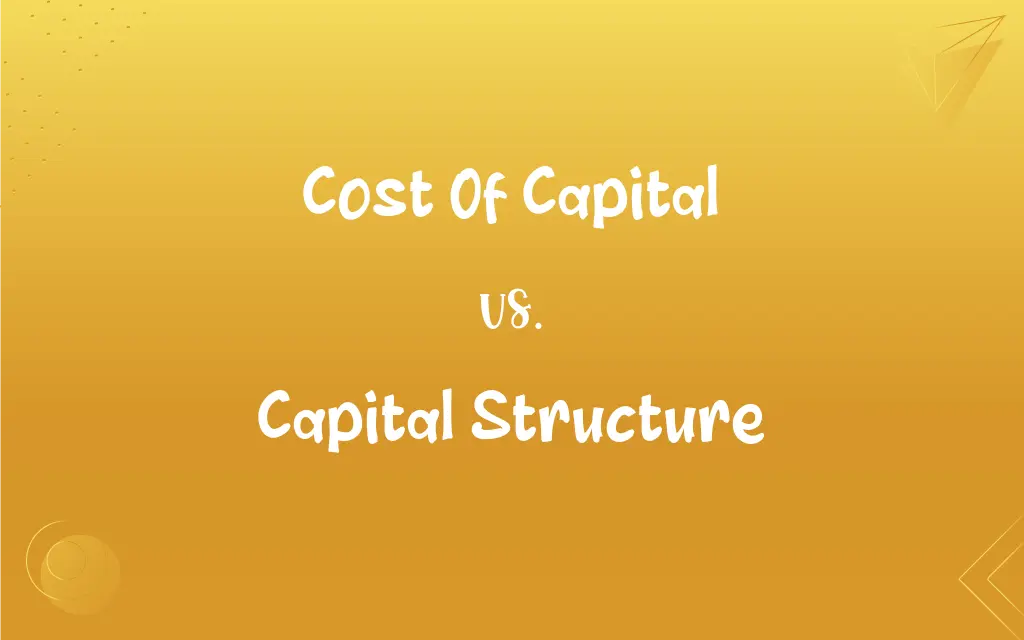Cost Of Capital vs. Capital Structure: What's the Difference?
Edited by Janet White || By Harlon Moss || Published on December 13, 2023
Cost of capital refers to the expense of obtaining funds for business operations, while capital structure is the mix of debt and equity used to finance a company.

Key Differences
Cost of capital is a financial metric that quantifies the expense a company incurs to secure funds, either through debt or equity. It reflects the return that investors expect for their investment in the business. Capital structure, in comparison, describes how a business finances its overall operations and growth by using different sources of funds, which may include debt, equity, or other financial instruments.
The cost of capital varies based on the method of financing; it can include interest on loans and required returns for equity investors. This cost is crucial in making investment and financing decisions, as it impacts the profitability of projects. Capital structure, however, focuses on the proportion of debt and equity in financing the company’s assets. It determines the firm's risk profile and influences its cost of capital.
In calculating the cost of capital, companies assess the expense of each type of financing, including debt, equity, and any hybrid instruments, and often use the weighted average cost of capital (WACC) as a comprehensive measure. The capital structure is instrumental in this calculation as it influences the weights of debt and equity in the WACC formula.
Strategic decisions in a company, like funding new projects or expansion, depend significantly on the cost of capital, as it helps in evaluating the financial viability of these initiatives. Conversely, decisions about the capital structure are essential for managing the company's financial risk and flexibility, balancing the use of debt and equity to optimize financial performance.
The cost of capital is dynamic and can change with market conditions, interest rates, and the company's financial health. A well-designed capital structure aims to minimize the cost of capital while ensuring sufficient funding for business activities and growth, reflecting a strategic balance between risk and return.
ADVERTISEMENT
Comparison Chart
Definition
The expense incurred to obtain funds for operations.
The mix of debt and equity used to finance a company.
Focus
On the cost associated with each source of finance.
On the proportion and mix of financing sources.
Impact
Influences investment and financing decisions.
Affects company's risk profile and financial flexibility.
Calculation
Determined by the weighted average cost of capital (WACC).
Based on the proportion of debt to equity.
Strategic Relevance
Used to assess profitability and viability of projects.
Important for managing financial risk and stability.
ADVERTISEMENT
Cost Of Capital and Capital Structure Definitions
Cost Of Capital
The required return a company must earn on its investments to maintain its market value.
The company's cost of capital increased due to rising interest rates.
Capital Structure
The way a corporation finances its assets through a combination of debt, equity, or hybrid securities.
A stable capital structure was key to the company's long-term growth strategy.
Cost Of Capital
The rate of return that could have been earned by putting the same money into a different investment with equal risk.
They evaluated the new project's feasibility against their cost of capital.
Capital Structure
The balance between different types of capital such as debt and equity used by a company.
They restructured their capital structure to improve financial flexibility.
Cost Of Capital
The cost of funds used for financing a business.
The firm's cost of capital was a key factor in its decision to not pursue the expansion.
Capital Structure
The composition of a company’s liabilities and shareholders' equity.
The firm adjusted its capital structure to include more equity and less debt.
Cost Of Capital
A company's cost of borrowing or the return that equity investors expect on their investment.
Reducing the cost of capital was essential for the company to increase its profitability.
Capital Structure
The financial framework of a company determining how it is funded.
The new CFO was tasked with optimizing the company's capital structure.
Cost Of Capital
The opportunity cost of making a specific investment.
The startup calculated its cost of capital to determine the pricing of its new product.
Capital Structure
The ratio of different types of securities issued by a company to fund its operations.
Analysts focused on the capital structure to assess the company's risk profile.
FAQs
Can the cost of capital change over time?
Yes, it can change due to market conditions, company performance, and interest rate fluctuations.
What determines a company's cost of capital?
It's determined by the rate of return expected by its investors and the cost of its debts.
How does capital structure affect a company?
It affects the company’s risk profile, financial flexibility, and potentially its stock valuation.
What is weighted average cost of capital (WACC)?
WACC is the average rate of return a company is expected to pay its security holders.
Why is capital structure important?
It's important for maintaining a balance between risk and growth, and for optimizing financial performance.
How is the cost of equity calculated?
It's often calculated using models like the Capital Asset Pricing Model (CAPM).
Is a lower cost of capital always better?
Generally yes, as it indicates cheaper financing, but it should also align with the company’s risk profile.
What role does debt play in capital structure?
Debt can provide tax benefits but also increases financial risk and obligations.
What is an optimal capital structure?
An optimal capital structure minimizes the cost of capital and maximizes shareholder value.
What factors influence capital structure decisions?
Factors include market conditions, company strategy, industry norms, and financial health.
Does cost of capital vary between companies?
Yes, it varies based on factors like business risk, industry, and financial stability.
How does equity financing affect capital structure?
Equity financing increases shareholder participation and dilutes ownership but doesn't incur debt.
How do dividends affect the cost of capital?
Dividends can impact the cost of equity, as they are a factor in investor return expectations.
What is the significance of a company's capital structure in investment decisions?
It helps investors assess risk and return potential, influencing investment attractiveness.
Is capital structure static or dynamic?
It's dynamic and can change over time based on company strategy and financial needs.
Does a high cost of capital indicate a high-risk company?
Often yes, as it suggests investors require more return for the perceived risk of investing in the company.
How do interest rates impact the cost of capital?
Higher interest rates can increase the cost of debt, thereby increasing the overall cost of capital.
Why might a company change its capital structure?
To optimize financial performance, manage risk, or adapt to changes in market conditions or business objectives.
What is the difference between short-term and long-term cost of capital?
Short-term cost of capital relates to immediate financing needs, while long-term cost reflects ongoing funding costs.
Can a company have too much debt in its capital structure?
Yes, excessive debt increases financial risk and can lead to financial distress or bankruptcy.
About Author
Written by
Harlon MossHarlon is a seasoned quality moderator and accomplished content writer for Difference Wiki. An alumnus of the prestigious University of California, he earned his degree in Computer Science. Leveraging his academic background, Harlon brings a meticulous and informed perspective to his work, ensuring content accuracy and excellence.
Edited by
Janet WhiteJanet White has been an esteemed writer and blogger for Difference Wiki. Holding a Master's degree in Science and Medical Journalism from the prestigious Boston University, she has consistently demonstrated her expertise and passion for her field. When she's not immersed in her work, Janet relishes her time exercising, delving into a good book, and cherishing moments with friends and family.








































































